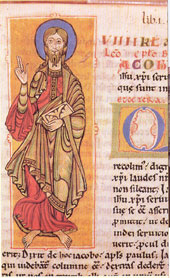Codex Calixtinus
manuscript collection From Wikipedia, the free encyclopedia
Remove ads
The Codex Calixtinus is an important 12th-century manuscript linked to the Way of St. James pilgrimage in Spain. It is kept in the Santiago de Compostela Cathedral and is also called the Liber Sancti Jacobi, or the Book of Saint James.

This codex is a collection of texts created to support and encourage the pilgrimage to the shrine of Saint James the Great in Santiago de Compostela. Although it was once believed to be written by Pope Callixtus II, scholars now think the main compiler was the French cleric Aymeric Picaud. The manuscript was likely put together between 1138 and 1145.
Remove ads
Contents
The codex is divided into five books and two appendices, each serving a distinct purpose:
- Book I: Contains sermons and liturgical texts related to Saint James.
- Book II: Details 22 miracles attributed to Saint James.
- Book III: Describes the journey of Saint James's body from Jerusalem to Galicia.
- Book IV: Narrates the story of Charlemagne and Roland, linking their exploits to the Camino de Santiago.
- Book V: Serves as a guide for pilgrims, offering practical advice on routes, accommodations, and local customs.
Additionally, the appendices include musical pieces, making the codex one of the earliest sources of polyphonic music in Europe.
Remove ads
Importance
The Codex Calixtinus is considered one of the most important documents of Christianity and a true guide for the Way of St. James. It played a crucial role in promoting the pilgrimage to Santiago de Compostela, establishing it as a major Christian pilgrimage route. The manuscript offers insights into medieval religious practices, art, music, and the experiences of pilgrims during that era.
In 2017, UNESCO added the codex to its Memory of the World International Register which lists globally important documents.[1]
Remove ads
Theft and recovery
On July 5, 2011, the codex was stolen from the Cathedral of Santiago de Compostela. After a year-long investigation, it was recovered in July 2012 from the garage of a former cathedral employee. The theft highlighted the manuscript's value and the need for improved security measures.
References
Wikiwand - on
Seamless Wikipedia browsing. On steroids.
Remove ads
